Text by Cynthia Yoken; Layout by Judy Farrar
Seventy years ago, while the Germans were in retreat, American soldiers liberated the Nazi concentration camps. It was April, 1945, one month before the end of the war in Europe. A number of local veterans took part in the liberation. Their stories are preserved in the Archives of the Center for Jewish Culture at the Claire T. Carney Library, University of Massachusetts Dartmouth.
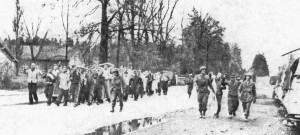 The first camp to be liberated was the concentration camp of Buchenwald, located near Weimar, Germany. The camp was liberated on April 11, 1945 by the soldiers in the Sixth Armored Division of the US Third Army, commanded by George S. Patton. There were about 21,000 prisoners at Buchenwald on the day it was liberated, including approximately 4,000 Jewish prisoners who were survivors from the death camps in Poland. There were also 904 children under the age of 17, many of whom were orphans. The most famous survivor from Buchenwald is the acclaimed author, Elie Wiesel.
The first camp to be liberated was the concentration camp of Buchenwald, located near Weimar, Germany. The camp was liberated on April 11, 1945 by the soldiers in the Sixth Armored Division of the US Third Army, commanded by George S. Patton. There were about 21,000 prisoners at Buchenwald on the day it was liberated, including approximately 4,000 Jewish prisoners who were survivors from the death camps in Poland. There were also 904 children under the age of 17, many of whom were orphans. The most famous survivor from Buchenwald is the acclaimed author, Elie Wiesel.
Some of the local liberators of Buchenwald from our area were Judge Milton Silva, Lucien Rego, and Martin Damgaard.
Milton Silva was born in Fall River in 1923 and was drafted while he was attending the Boston School of Anatomy Embalming. He was in the medical battalion as part of the 8th armored division, and then ended up with the 104th Infantry Division. He arrived in Europe in March 1945 and was the truck driver for his outfit. As he approached Buchenwald, there was a stench of death that the soldiers could smell. It was a shock for him upon entering the gates at Buchenwald and seeing people practically naked with the little clothes they wore, torn and dirty, looking like skeletons. Also there were stacks of bodes outside the crematoria and not fully consumed bodies in the ovens. There were people walking around sort of like walking skeletons, not saying much and some were crying. Milton Silva was a Medic in the field 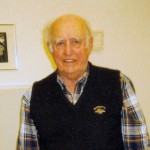 with the 120th Evacuation hospital. He helped those who needed medical help. As a truck driver, he went to get food and clothing. He was sent out to help the 150th evacuation hospital move into Nordhausen Concentration Camp, a sub-camp to Buchenwald. He finally ended up in Cham taking care of displaced people. He didn’t stay in Buchenwald very long because the primary illness there was tuberculosis and they needed doctors trained in that disease.
with the 120th Evacuation hospital. He helped those who needed medical help. As a truck driver, he went to get food and clothing. He was sent out to help the 150th evacuation hospital move into Nordhausen Concentration Camp, a sub-camp to Buchenwald. He finally ended up in Cham taking care of displaced people. He didn’t stay in Buchenwald very long because the primary illness there was tuberculosis and they needed doctors trained in that disease.
Lucien Rego was born in Fall River on April 15, 1925. Mr. Rego was drafted into the army on August 6, 1943. He spent most of the war overseas as a Private, PFC, seeing combat with the 5th armored division as a Demolition Man. From January to June 1944 he was responsible for packing parachutes on the planes with ammunition in front for the underground in England. He was with a tank force and also fought in the Battle of the Bulge from the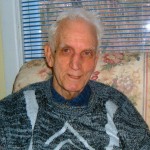 16th of December until January. As he approached Buchenwald in late March 1945, he remarked about the odor all around. His group was there long enough to take pictures. This was a camp of all men.
16th of December until January. As he approached Buchenwald in late March 1945, he remarked about the odor all around. His group was there long enough to take pictures. This was a camp of all men.
Lt. Col. Martin Jens Damgaard, the father of Neil Damgaard, Protestant chaplain at UMass Dartmouth was a camouflage engineer with the 602nd Camouflage Battalion of General Hodges’ First Army. He went ashore on Omaha Beach with his unit and was in and out of the Bunker in Berlin. Captain Damgaard was also one of the liberators of the Buchenwald 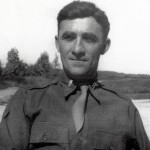 Concentration Camp arriving there on day one of the liberation of the camp. After the war, Martin Damgaard worked for the US Army Corps of Engineers for the rest of his career until his retirement in 1973.
Concentration Camp arriving there on day one of the liberation of the camp. After the war, Martin Damgaard worked for the US Army Corps of Engineers for the rest of his career until his retirement in 1973.
The Bergen-Belsen Concentration Camp was voluntarily turned over to the Allied 21st army group, a combined British-Canadian unit on April 15, 1945 by Heinrich Himmler who was in charge of all the camps. Abe and Freida Landau who came to New Bedford in 1950 were prisoners in this camp.
The liberation of Dachau by the US Seventh Army occurred on April 29, 1945 one week before the end of World War II in Europe. Two divisions of the Seventh Army, the 42nd Rainbow Division and the 45th Thunderbird Division, participated in the liberation, while the 20th Armored Division provided support. The 101st Tank Battalion was attached to the 45th Thunderbird Division. The 101st Tank Battalion arrived in Dachau at 9:30 am on April 29th. The local liberators of Dachau were Eli Heimberg (with the Rainbow Division), Nate Barry, Walter Lalor, Col. John Richmond Kinney, Jr., and Norman Chartier.
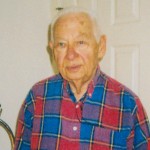 Eli Heimberg was born in Chelsea , Ma and his family moved to Yonkers, NY from where he was drafted. He entered the camp with Chaplain Eli Bohnen and the first thing they saw were mounds, 10, 15 feet high of clothing, and shoes. They went into the Jewish barracks and saw people who were gaunt. Captain Bohnen introduced himself to the prisoners who had been liberated that morning. He took names and addresses of people they wanted to contact. It was April 29, 1945. Before going into the barracks, they saw railroad cars with the prisoners dressed in ill-clad, striped pajama. Mr. Heimberg recalled a picture in his mind of a man sitting dead with his eyes opened . Eli Heimberg was with the 42nd infantry division and his job was as an aide and assistant to the chaplain.
Eli Heimberg was born in Chelsea , Ma and his family moved to Yonkers, NY from where he was drafted. He entered the camp with Chaplain Eli Bohnen and the first thing they saw were mounds, 10, 15 feet high of clothing, and shoes. They went into the Jewish barracks and saw people who were gaunt. Captain Bohnen introduced himself to the prisoners who had been liberated that morning. He took names and addresses of people they wanted to contact. It was April 29, 1945. Before going into the barracks, they saw railroad cars with the prisoners dressed in ill-clad, striped pajama. Mr. Heimberg recalled a picture in his mind of a man sitting dead with his eyes opened . Eli Heimberg was with the 42nd infantry division and his job was as an aide and assistant to the chaplain.
Nate Barry was born in Quincy, Massachusetts on April 7, 1925. Nate was drafted into the army along with the entire graduating class from Quincy High school in1943. In the army 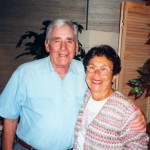 he was in the Armored Infantry Patrol. Nate was on an open-top tank with a 105 Harronson Locomotive and in the right corner of the tank was a turret. Mounted on that turret was a 50-caliber machine which Nate operated. Nate’s outfit landed on Omaha Beach in July 1944. He fought in the battle of Ramangan Bridge, on the Arno Rive and their last big fight was an SS outfit outside of Munich. Nate’s outfit arrived at Dachau about an hour after the first troops. They were on a 2-lane road and as they were going along, they suddenly saw ghost-like figures in the striped uniform, in striped outfits, screaming on both sides of the road. They were Polish. They were alive, hardly healthy, but as soon as the gates were opened, they just got out, and they wanted to get out. When they approached the camp, Nate saw a little boy standing at the fence and gave him his chocolate from the sea ration. Then the Medics came by and said not to feed them. Nate explained that the camp itself was unbelievable; he was looking at carloads of skeletons and pits full of bodies and he didn’t know the extent of what they had done. Dachau was only 12 miles out of Munich so they went there to get dignitaries to show them. The same name on the gate as in the other concentration camps was here, “Arbeit Mach Frei,” and Nate said the camp was terrible to see.
he was in the Armored Infantry Patrol. Nate was on an open-top tank with a 105 Harronson Locomotive and in the right corner of the tank was a turret. Mounted on that turret was a 50-caliber machine which Nate operated. Nate’s outfit landed on Omaha Beach in July 1944. He fought in the battle of Ramangan Bridge, on the Arno Rive and their last big fight was an SS outfit outside of Munich. Nate’s outfit arrived at Dachau about an hour after the first troops. They were on a 2-lane road and as they were going along, they suddenly saw ghost-like figures in the striped uniform, in striped outfits, screaming on both sides of the road. They were Polish. They were alive, hardly healthy, but as soon as the gates were opened, they just got out, and they wanted to get out. When they approached the camp, Nate saw a little boy standing at the fence and gave him his chocolate from the sea ration. Then the Medics came by and said not to feed them. Nate explained that the camp itself was unbelievable; he was looking at carloads of skeletons and pits full of bodies and he didn’t know the extent of what they had done. Dachau was only 12 miles out of Munich so they went there to get dignitaries to show them. The same name on the gate as in the other concentration camps was here, “Arbeit Mach Frei,” and Nate said the camp was terrible to see.
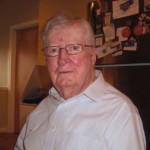 Walter Lalor was born in Dorchester, Massachusetts on March 20, 1916. He was living in Framingham when he was drafted into the medical service branch. Walter was a bacteriologist in the medical corps. He was in the Battle of the Bulge and arrived in Dachau a week after it was liberated by the Third Army. Mr. Lalor was in the Sixth Army. He found the experience in Dachau very shocking and the chaos was out of this world, from his prospective, humanity destroying other humanity the way it did.
Walter Lalor was born in Dorchester, Massachusetts on March 20, 1916. He was living in Framingham when he was drafted into the medical service branch. Walter was a bacteriologist in the medical corps. He was in the Battle of the Bulge and arrived in Dachau a week after it was liberated by the Third Army. Mr. Lalor was in the Sixth Army. He found the experience in Dachau very shocking and the chaos was out of this world, from his prospective, humanity destroying other humanity the way it did.
John Richmond Kinney Jr. was born on May 15, 1915. After graduating from Holy Family High School in 1932, he enlisted in the Battery “D”, Second Battalion, 101st Field Artillery Regiment, Massachusetts National Guard. When America entered World War II at the end of 194l, Mr. Kinney was selected to attend Officer Candidate School at Fort Sill, Oklahoma where he received his commission as Second Lieutenant. He served stateside for several years, then in January 1945, he was deployed to France as a forward air observer in the 20th Armored Division. Kinney survived 3 airplane crashes while on reconnaissance missions. The 20th Armored Division was credited with the liberation of Dachau where Kinney witnessed firsthand the horrors of the Nazi regime. After the war, John Kinney returned to New Bedford and continued his military career in the National Guard. He was promoted to Colonel in 1965 and in 1969 he retired with the honorary rank of brigadier general. His grandson, Jonathan Mitchell, is the current mayor of New Bedford.
Norman Chartier was born in New Bedford in 1922 and was an active communicant and volunteer at Holy Name of the Sacred Heart of Jesus Parish. Mr. Chartier was a dedicated soldier who served as a medic in the U.S. Army during World II. Norm was in the 4th Infantry Division which landed at Utah Beach in July 1944. His unit fought the Germans in France throughout 1944 and in 1945. His unit arrived in Dachau in May of 1945 just after it was liberated, but he saw the horrors of the Nazi atrocities and the after effects. As a docent at the Fort Taber Fort Rodman Military Museum, he enjoyed speaking to visitors about his war experiences. He was the Grand Marshall in the Veterans Parade in November 2014. He died on January 5, 2015.
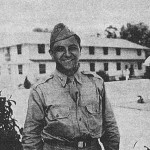 Mauthausen was a concentration camp located in Austria for communist, political prisoners and German criminals. It was also an “end destination” for Jews from the death camps in Poland. On May 5, 1945, the official date of the liberation of this camp, a platoon of 23 men from the 11th Armored Division of the U.S. Third Army, led by staff sergeant Albert J. Kosieki, arrived at the main camp near the town of Mauthausen. The local liberator from New Bedford was Dr. Konstantine Yankopoulos.
Mauthausen was a concentration camp located in Austria for communist, political prisoners and German criminals. It was also an “end destination” for Jews from the death camps in Poland. On May 5, 1945, the official date of the liberation of this camp, a platoon of 23 men from the 11th Armored Division of the U.S. Third Army, led by staff sergeant Albert J. Kosieki, arrived at the main camp near the town of Mauthausen. The local liberator from New Bedford was Dr. Konstantine Yankopoulos.
Konstantine Yankopoulos was born in Votanion, Macedonia, Greece on April 15, 1916. He lived in Greece until he was 6 years old and then came to New Bedford. Dr. Yankopoulos was drafted in the army in 1942 after he finished medical school at BU. He was in the medical corps, serving as an anesthetist for anesthesia instead of a battalion aid surgeon. He landed in Normandy and he helped to set up the first field hospital there. After traveling through Northern Europe, he went into the camp of Ebensee in Southern Germany near the border of Austria and then one camp that he saw in detail, Mauthausen in Oberneubirchen, Austria at the end of the war in Europe. In Mauthausen he saw bodies piled up like cord wood alongside of the camp there. One of the victims was playing his hand organ, a little music box, way up on the tower and Dr. Yankopoulos cried because he was playing it so plaintively. Yankopoulos ran into people that survived who told him the hell they had gone through for the past 4 years and how they were either slave laborers or forced laborers and that they were treated badly. Some of these prisoners he saw were Jews and even Greek Jews from Salonika. When the war was over on May 9, 1945, he was in Austria at the Mauthausen camp.
For access to the transcripts of the interviews conducted with these liberators, or for information on the Archives of the Center for Jewish Culture’s oral history project, contact Judy Farrar at the Claire T. Carney Library Archives and Special Collections at jfarrar@umassd.edu. For more information on the Archives of the Center for Jewish Culture, please consult the web site at http://www.lib.umassd.edu/archives/center-jewish-culture-ohp
Cynthia Yoken’s text was also published in the Standard Times on April 19, 2015 at:
http://www.southcoasttoday.com/article/20150419/OPINION/150419405

